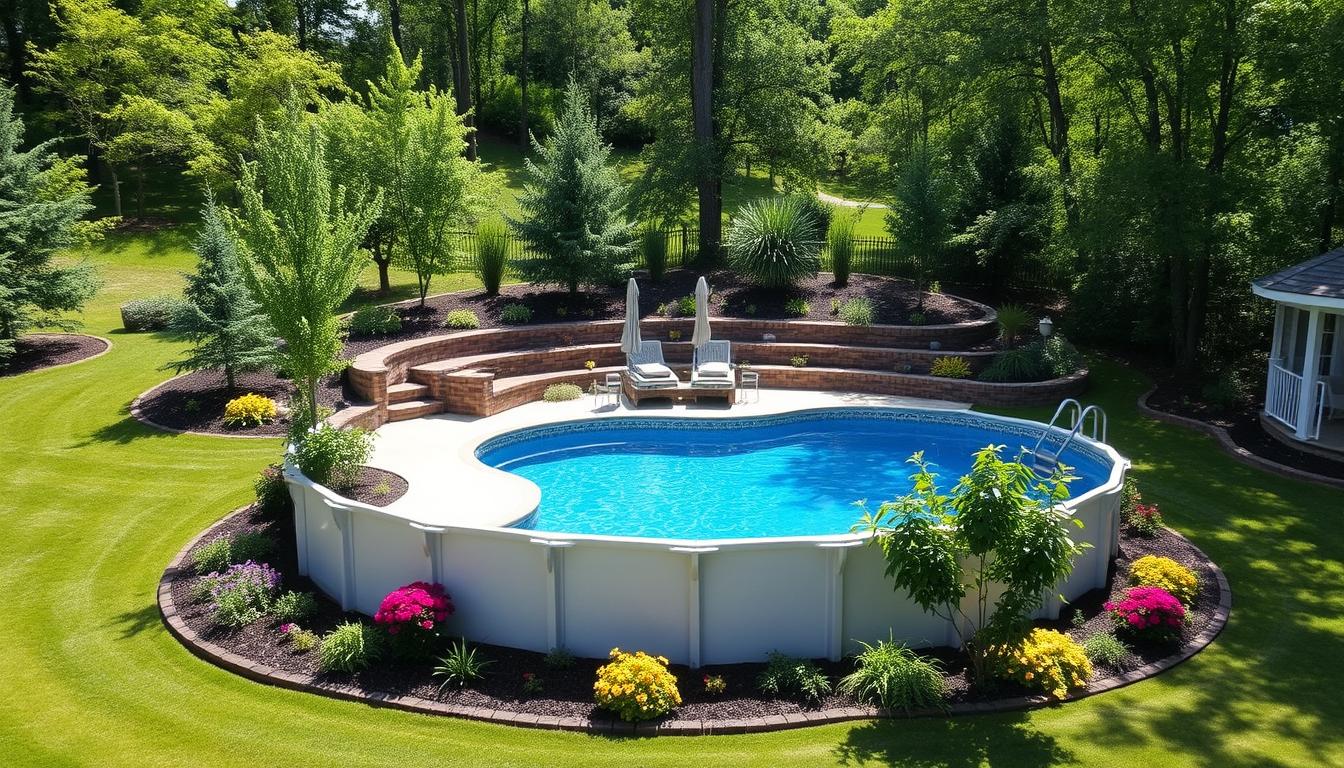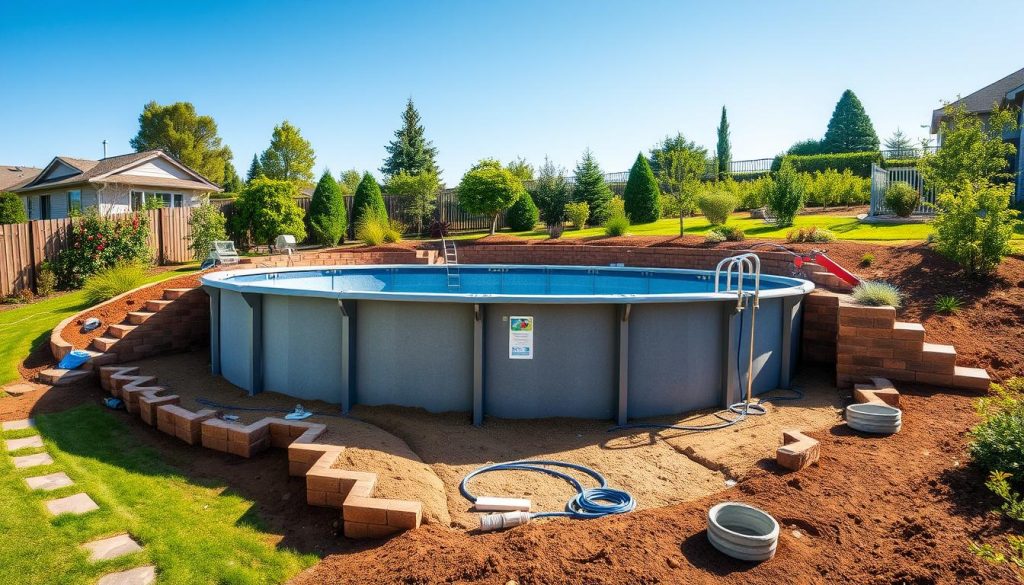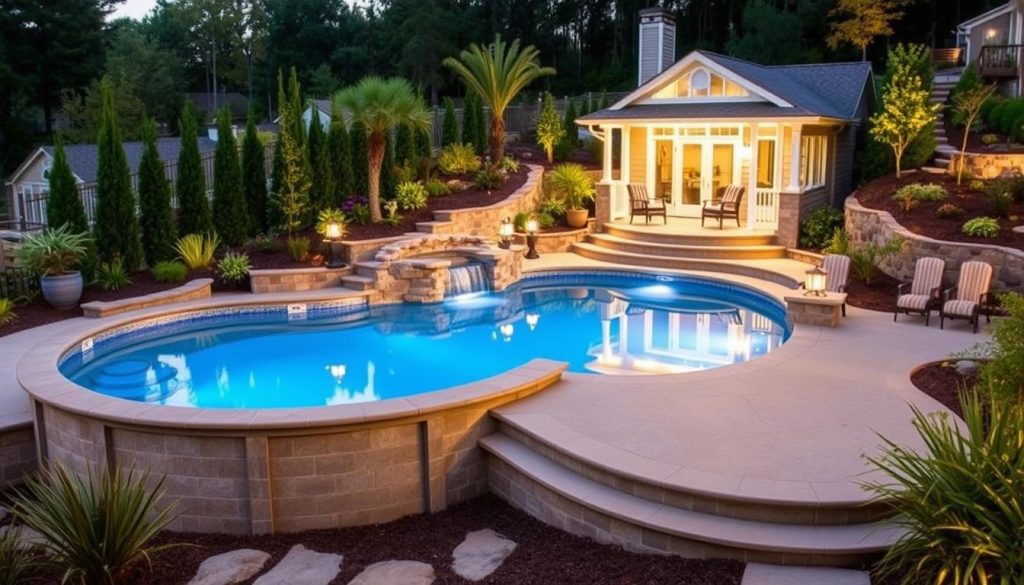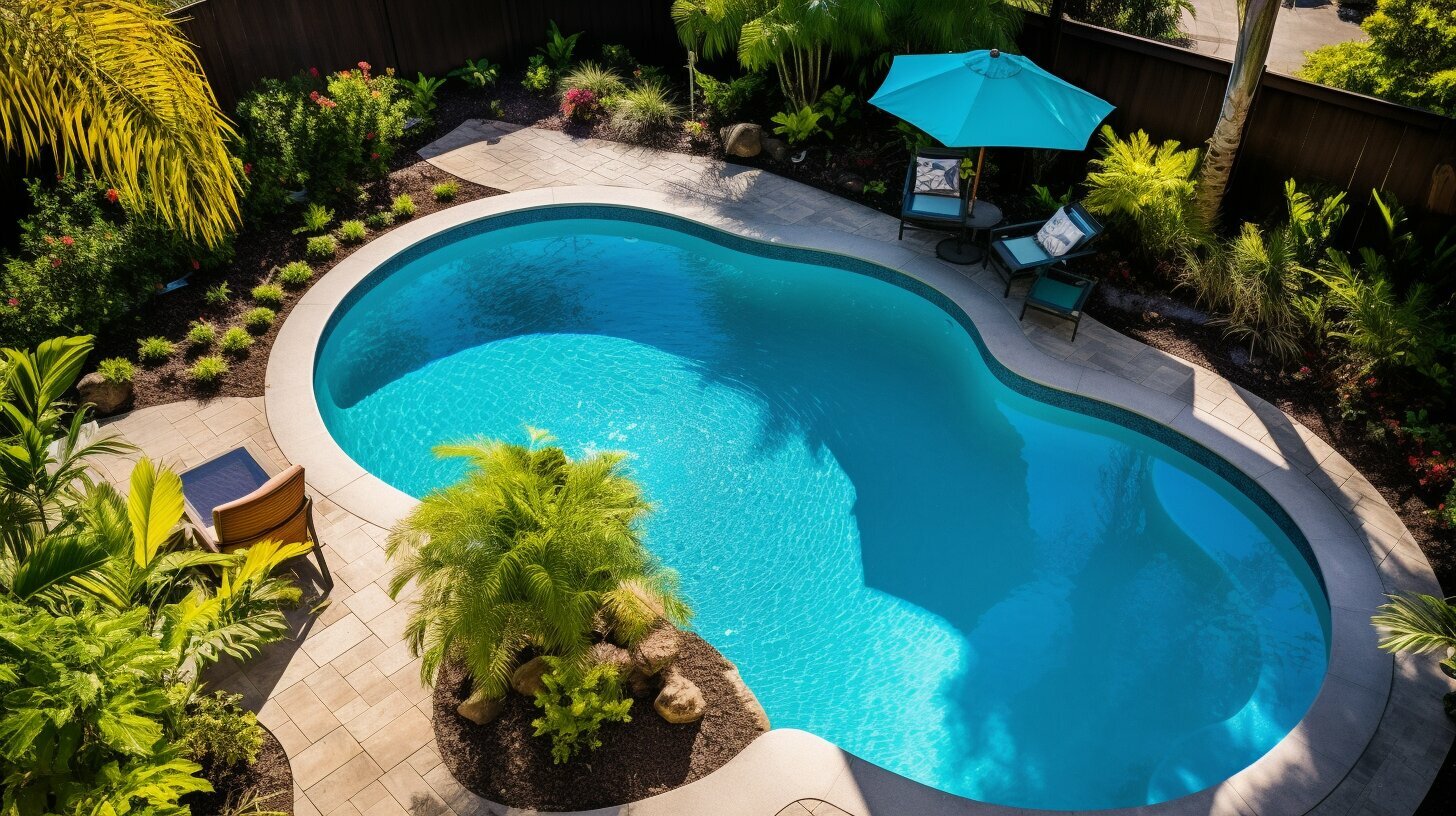
Don’t let a sloped yard crush your pool dreams! With careful planning, you can install an above-ground pool on uneven terrain. Let’s explore how to create above ground pool on sloped yard.
We’ll guide you through setting up a pool on uneven ground. This will ensure a safe and fun swimming experience for your family.
Installing a pool on a slope requires careful thought. You must consider the slope angle, soil conditions, and local rules. The right pool type depends on your budget, design preferences, and slope severity.
We’ll help you tackle the challenges of sloped terrain. You’ll gain the knowledge to build a stunning poolside retreat.
Key Takeaways
- Assess the slope angle, soil conditions, and local regulations before installing a pool on a sloped yard
- Choose the right type of pool based on your budget, desired design, and the severity of the slope
- Proper excavation, leveling, and construction of retaining walls are crucial for a stable and safe pool area
- Ensure adequate drainage to prevent erosion and soil displacement
- Consider landscaping options to enhance the beauty and functionality of your poolside retreat
How to Install a Pool on a Slope?
Installing a pool on a slope can be tricky. But with careful planning, you can create a stunning backyard oasis. Following best practices ensures stability, safety, and longevity of your swimming pool.
What Are the Best Practices for Pool Installation on a Sloped Yard?
To install a pool on a slope successfully, follow these best practices:
- Conduct a thorough site inspection to assess the slope’s angle, soil conditions, and drainage.
- Plan the pool design carefully, considering the slope’s contours and the desired pool features.
- Perform proper excavation and leveling of the ground to create a stable foundation for the pool.
- Install retaining walls, if necessary, to stabilize the soil and prevent erosion.
- Ensure adequate drainage around the pool area to prevent water accumulation and potential damage.
Do I Need a Retaining Wall for My Pool on a Hill?
The need for a retaining wall depends on the slope’s angle and soil conditions. Retaining walls stabilize soil, prevent erosion, and create a level surface for the pool.
Common types of retaining walls include:
- Gravity walls: Suitable for shorter slopes with stable soil conditions.
- Cantilever walls: Ideal for taller slopes or areas with limited space.
- Anchored walls: Recommended for steep slopes or unstable soil conditions.
Consult a professional pool installer or engineer to determine the best solution for your site.
How to Level the Ground for an Above-Ground Pool?
Leveling the ground is crucial for installing an above-ground pool on a slope. The process typically involves these steps:
- Remove the topsoil and any vegetation from the pool area.
- Create a level base using sand or gravel, ensuring a consistent depth throughout.
- Compact the surface using a plate compactor or hand tamper to ensure stability.
- Install a solid foundation, such as concrete pads or pavers, for the pool’s support structure.
- Regularly check the level of the ground during installation and make adjustments as needed.
| Pool Installation Step | Description |
|---|---|
| Site Inspection | Assess the slope’s angle, soil conditions, and drainage |
| Excavation | Remove topsoil and level the ground for the pool foundation |
| Retaining Walls | Install walls to stabilize soil and prevent erosion, if necessary |
| Leveling | Create a level base using sand or gravel and compact the surface |
| Foundation | Install a solid foundation, such as concrete pads or pavers |
Careful planning is key to a successful pool installation on a slope. By following these practices, you’ll create a beautiful backyard retreat for your family.
What Are the Challenges of Having a Swimming Pool on a Slope?
Installing a pool on sloped terrain poses unique challenges. The slope’s angle and soil type impact the installation process. Specialized designs and support structures are needed for pool stability.
Careful planning and execution are crucial. These ensure the pool’s longevity on challenging terrain. Professional help is often necessary for successful installation.

How Does Slope Affect Pool Installation?
The slope’s steepness determines installation complexity. Steep slopes need extensive engineering and construction techniques. These ensure the pool’s stability and safety.
Common techniques include excavation, grading, and retaining walls. Drainage systems and specialized designs may also be necessary. Soil type can further complicate the process.
- Excavation and grading to create a level surface for the pool
- Incorporating retaining walls to stabilize the pool’s foundation and prevent soil erosion
- Drainage systems to manage water runoff and prevent flooding
- Specialized pool designs, such as infinity edges or multi-level pools, to accommodate the slope
What Are Common Issues with a Ground Pool on a Slope?
Improper planning can lead to several problems. These include soil erosion, instability, and structural damage. Water runoff and drainage issues are also common.
Cracks may form in the pool shell or deck. Maintaining proper water levels can be challenging. Regular maintenance is crucial to address these issues.
- Soil erosion and instability, leading to structural damage to the pool and surrounding areas
- Water runoff and drainage problems, causing flooding and damage to the pool and landscaping
- Cracks in the pool shell or deck due to uneven settling or shifting soil
- Difficulty maintaining proper water levels and chemistry due to the slope’s impact on circulation and filtration systems
Can I Swim Safely in a Pool on a Hill?
Swimming in a hill-side pool can be safe and enjoyable. Proper design and construction are key. Experienced professionals should handle the unique challenges of sloped terrain.
They ensure the pool meets all safety standards. This creates a secure and relaxing environment for swimmers.
By consulting with skilled pool builders and engineers, homeowners can create a stunning and secure pool area that seamlessly integrates with the natural slope of their yard, providing years of enjoyment and relaxation.
| Slope Type | Installation Challenges | Potential Solutions |
|---|---|---|
| Gentle (1-3%) | Minimal grading and excavation required | Standard pool designs and construction methods |
| Moderate (4-8%) | Increased excavation and grading, potential drainage issues | Retaining walls, specialized pool designs, drainage systems |
| Steep (9%+) | Extensive excavation, soil instability, complex drainage requirements | Terracing, multi-level pools, engineered retaining walls, advanced drainage solutions |
What Is the Best Type of Pool for a Sloped Yard?
Choosing a pool for a sloped backyard involves considering budget, features, and slope severity. The right pool design can create a functional and appealing outdoor space.
Several options are available, each with its own pros and cons. Finding the perfect design is crucial for enhancing your sloped yard.

Are Above-Ground Pools Suitable for Sloped Terrain?
Above-ground pools are cost-effective for sloped yards. They need minimal excavation and can adapt to moderate slopes. These pools are partially buried and offer durability at a lower cost.
Custom decks and fences can make above-ground pools look like inground ones. However, for steeper inclines, semi-inground or inground pools may be more suitable.
What Should I Consider When Choosing a Pool Design for a Sloped Backyard?
Key factors to consider for your sloped backyard pool design include:
- Available space and the degree of the slope
- Soil conditions and local building codes
- Budget and desired features
- Aesthetics and integration with the existing landscape
Popular pool design options for sloped yards include:
| Pool Design | Description |
|---|---|
| Infinity Pools | Provides an elegant touch and visual effect of water extending into the horizon, suitable for steep or extreme slopes. |
| Multi-level Terraces | Supported by tall stone retaining walls, offering stable spaces at different elevations in sloped yards. |
| Semi-inground Pools | Partially buried in the ground, providing the durability and look of a traditional pool at a lower cost, suitable for small backyards. |
| Container Pools | Well-insulated and can be fully or partially buried in the ground, offering versatility for unconventional backyard layouts. |
Retaining walls are crucial for supporting slopes and preventing erosion. They stabilize the ground for pool installations in sloped yards. A level base is essential for pool functionality, safety, and durability.
The pool deck should balance functionality and aesthetics. It can include built-in seating, sunken lounges, or elevated platforms.
Incorporating natural elements like ornamental grasses, tall stone elements, and tropical trees can help blend the pool area with its surroundings in sloped yards, creating a cohesive and visually appealing outdoor space.
The best pool design depends on your needs, preferences, and yard characteristics. Consider these factors and work with experienced professionals to create your perfect pool oasis.
How to Landscape a Pool Area for above ground pool on sloped yard?
Sloped backyards can become stunning pool oases with smart planning. We can turn challenging hillsides into breathtaking retreats using creative design elements. Let’s explore innovative pool landscape ideas for sloped yards.
We’ll also discuss how to build a deck around your above-ground pool on a hill. These ideas will help you make the most of your sloped terrain.
What Are Innovative Pool Landscape Ideas for Sloped Yards?
Landscaping for above-ground pools on slopes requires creative thinking. Here are some innovative ideas to consider:
- Terracing: Create multiple levels around your pool to maximize space and add visual interest. Each level can feature seating areas, gardens, or water features.
- Rock Gardens: Use natural rock formations to blend with the sloped terrain. They provide a stunning backdrop and help control erosion.
- Water Features: Add a waterfall, stream, or fountain to create a peaceful atmosphere. These elements enhance the natural beauty of your sloped yard.
- Multi-Level Decking: Design a tiered deck around your above-ground pool. This helps navigate the slope while providing space for lounging and entertaining.
A tiered pool or a multi-level terrace can make every inch of a sloped backyard a valuable part of the pool layout.
How to Build a Deck Around Your Above-Ground Pool on a Hill?
Building a deck on a hill requires careful planning. Follow these steps for success:
- Assess the slope’s angle and the pool’s shape to determine the best deck design.
- Create a multi-tier deck that navigates the terrain and provides space for seating and movement.
- Ensure proper support by using sturdy posts and beams anchored securely into the hillside.
- Install railings and barriers for safety and to comply with local building codes.
- Choose weather-resistant and slip-resistant decking materials suitable for pool environments.
Hire experienced professionals for your sloped yard pool deck project. They can navigate unique terrain challenges and create a structurally sound, visually appealing deck.
| Pool Type | Suitability for Sloped Yards | Cost Considerations |
|---|---|---|
| Above-Ground Pools | Most budget-friendly option | Lower installation costs |
| In-Ground Pools | Higher design flexibility | Requires extensive retaining walls, higher costs |
| Semi-In-Ground Pools | Middle-ground option | Moderate cost and design flexibility |
Embrace your yard’s natural slope to create a stunning outdoor oasis. With careful planning and creative design, your sloped backyard can become an amazing relaxation spot.
Experienced professionals can help transform your above-ground pool area into the ultimate entertainment destination. Your sloped yard will soon be your favorite place to unwind.
What Is the Cost of Installing a above ground pool on sloped yard?
Installing a pool on a sloped yard can be pricey. Above-ground pool installation costs range from $1,600 to $7,500, with a national average of $4,500. Sloped terrain adds expenses like excavation, retaining walls, and drainage systems.
How to Budget for a Backyard Pool Installation on a Hill?
To budget for a hillside pool, get detailed quotes from multiple contractors. Consider the pool size, type, slope angle, and soil conditions.
Factor in excavation, grading, retaining walls, and drainage system costs. Don’t forget landscaping, decking, permits, and soil testing expenses.
- Size and type of pool (above-ground, semi-inground, or inground)
- Slope angle and soil conditions
- Excavation and grading costs
- Retaining wall construction
- Drainage system installation
- Landscaping and decking
Understanding all costs helps create a realistic budget. This approach prevents unexpected expenses later on.
What Additional Costs Should I Consider for a Sloped Yard?
Sloped yard pool installations come with extra costs. These expenses can greatly impact your budget.
| Additional Cost | Average Price Range |
|---|---|
| Excavation and grading | $1,000 – $5,000 |
| Retaining wall construction | $3,000 – $10,000 |
| Drainage system installation | $500 – $2,000 |
| Landscaping and decking | $2,000 – $10,000 |
| Permits and soil testing | $500 – $1,500 |
“Installing a pool on a sloped yard can be challenging, but with proper planning and budgeting, it’s possible to transform your backyard into a beautiful oasis.”
Including these costs in your budget ensures a smooth installation. It helps avoid financial surprises during your sloped yard pool project.
Can I Transform My Sloped Yard into a Dream Pool Oasis?
A sloped yard can become a stunning pool oasis with proper planning. Experienced professionals can help overcome uneven terrain challenges. The result? A functional and beautiful pool area that fits your lifestyle.
What Are the Steps to Create an Outdoor Pool Area on a Slope?
Begin by assessing the site and designing around the land’s natural contours. This may include terracing, retaining walls, and multi-level decks to manage erosion.
Choose materials like natural stone or timber to add texture and blend with the landscape. Water features like waterfalls can enhance ambiance and use the slope for circulation.
Native plants and xeriscaping techniques can reduce maintenance and boost biodiversity in your sloped backyard.
How to Incorporate Hot Tubs or Swim Spas in a Sloped Backyard?
Hot tubs or swim spas can add luxury to your sloped backyard oasis. They can be seamlessly integrated into the overall pool design.
Look for compact models with adjustable leveling systems for proper installation on slopes. Surround them with a deck or patio for easy access.
With smart design, you can enjoy pools and spas in your own sloped backyard paradise.
Quick Navigation
- How to Install a Pool on a Slope?
- What Are the Challenges of Having a Swimming Pool on a Slope?
- What Is the Best Type of Pool for a Sloped Yard?
- How to Landscape a Pool Area for above ground pool on sloped yard?
- What Is the Cost of Installing a above ground pool on sloped yard?
- Can I Transform My Sloped Yard into a Dream Pool Oasis?







